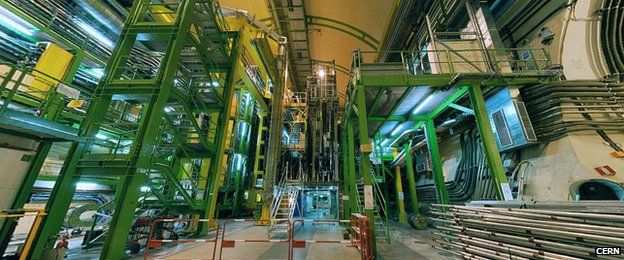LHC's D-meson study wraps up antimatter 'flip' story
- Published

Researchers at the Large Hadron Collider have witnessed particles called D-mesons flipping from matter into antimatter and back.
Antimatter is just like normal matter, but with opposite electric charge.
Such "oscillations" are well known among three other particle types, but this is the first time D-mesons have been seen doing it in a single study.
The team behind the collider's LHCb detector have put their results on the Arxiv repository.
The manuscript will be published in Physical Review Letters.
In the complicated zoo of subatomic physics, particles routinely decay into other particles, or spontaneously change from a matter type to their antimatter counterparts.
This "oscillation" forms an important part of the theory that attempts to tame the zoo - the Standard Model.
Mesons are part of a large family of particles made up of the fundamental particles known as quarks.
The protons and neutrons at the centres of the atoms of matter we know well are each made up of three such quarks.
Mesons, on the other hand, are made of just two - specifically one quark and one antimatter quark.
Theory holds that four members of the meson family can undergo the matter-antimatter oscillation - the matter and antimatter quarks both flip to their opposites.
Three particle types - K-mesons and two types of B-mesons had been caught in the act before.
LHCb has already been intimately involved in refining those prior measurements; in March 2012, the team confirmed earlier oscillation observations of a meson called Bs, and published the result in Physics Letters B.
On Tuesday, the team published results that set a new record of precision on the oscillations of the B0 meson, in the same journal.
The new paper represents the last of the four mesons that had never been seen flipping from matter to antimatter and back in a single measurement.
Other experiments had seen some evidence of the D-meson's flipping, but this is the first that crosses the "five sigma" level of statistical significance that particle physicists use to denote an official discovery.
"This is a nice moment, it's a sort of completeness," said Chris Parkes of the University of Manchester, spokesman for UK participation in the LHCb experiment.
"There are four systems in nature that oscillate, and this is the last one where a single-channel measurement has crossed the five-sigma threshold - we know now about mixing in all four of these systems," he told BBC News.
But what remains open is the question of why the Universe we see is made overwhelmingly of matter rather than antimatter - they should both have been created in equal measure during the Big Bang.
Mesons measured by LHCb have already hinted at an answer, and Prof Parkes says that is the next target.
"The LHC has had a tremendous first three years of operation, and now as we enter the first shutdown... we look forward to probing in great detail the [D meson] system using the data we've got so far and data to come."
- Published29 February 2012
- Published15 November 2011
- Published15 June 2011
- Published27 August 2011